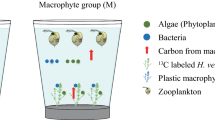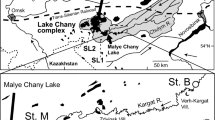Abstract
Acidifying organic samples prior to stable isotope analysis is a common practice to eliminate inorganic carbonates; however, it is still unclear what impact this has on δ 13C and δ 15N values. Here we present the first extensive study to test the effects of acidification on freshwater macrophyte carbon and nitrogen isotopic ratios. Focusing on the more productive and ecologically relevant seasons, we collected eleven common macrophyte species (both submerged and emergent), from four lakes in south-central Ontario, Canada. These lakes vary considerably in chemistry, particularly in the inorganic carbon and calcium concentrations. All individual plant samples were equally separated, prepared into acidified and un-acidified treatments, and analyzed for their carbon and nitrogen stable isotope ratios. No significant differences in macrophyte δ 13C or δ 15N were detected between the treatments. Additionally, we found that within-species δ 13C variability was greater in acidified samples. Finally, in assessing the isotopic values of different macrophytes across a chemical gradient at different times throughout the season, it became evident that natural variability exists in both the δ 13C and δ 15N of un-acidified samples within and between species. Based on these results, we assert that pre-analysis acidification of freshwater macrophytes from temperate lakes is unnecessary and not recommended. Additionally, we implore ecologists to acknowledge the macrophyte δ 13C and δ 15N variability in future food web studies.




Similar content being viewed by others
References
Allen ED, Spence DHN (1981) The differential ability of aquatic plants to utilize the inorganic carbon supply in freshwaters. New Phytol 87:269–283
Boon PI, Bunn SE (1994) Variations in the stable isotope composition of aquatic plants and their implications for food web analysis. Aquat Bot 48:99–108
Borowitzka MA (1984) Calcification in aquatic plants. Plant Cell Environ 7:457–466
Bosely KL, Wainwright SC (1999) Effects of preservatives and acidification on the stable isotope ratios (15N:14N, 13C:12C) of two species of marine animals. Can J Fish Aquat Sci 56:2181–2185
Brodie CR, Leng MJ, Casford JSL, Kendrick CP, Lloyd JM, Yongqiang Z, Bird MI (2011) Evidence for bias in C and N concentrations and δ13C composition of terrestrial and aquatic organic materials due to pre-analysis acid preparation methods. Chem Geol 282:67–83
Bunn S, Loneragan N, Kempster M (1995) Effects of acid washing on stable isotope ratios of C and N in penaeid shrimp and seagrass: implications for food-web studies using multiple stable isotopes. Limnol Oceanogr 40:622–625
Chamberlain CP, Blum JD, Holmes RT, Feng X, Sherry TW, Graves GR (1997) The use of isotope tracers for identifying populations of migratory birds. Oecologia 109:132–141
Cloern JE, Canuel EA, Harris D (2002) Stable carbon and nitrogen composition of aquatic and terrestrial plants of the San Francisco Bay estuary system. Limnol Oceanogr 47:713–729
DeNiro MJ, Epstein S (1981) Influence of diet on the distribution of nitrogen isotopes in animals. Geochim Cosmochim Acta 45:341–351
France RL (1987) Calcium and trace metal composition of crayfish (Orconectes virilis) in relation to experimental lake acidification. Can J Fish Aquat Sci 44:107–113
Fry B (1984) 13C/12C ratios and the trophic importance of algae in Florida Syringodium filiforme seagrass meadows. Mar Biol 79:11–19
Fry B (1988) Food web structure on Georges Bank from stable C, N, and S isotopic compositions. Limnol Oceanogr 33(5):1182–1190
Fry B (1991) Stable isotope diagrams of freshwater food webs. Ecology 72(6):2293–2297
Gu B, Schelske CL, Brenner M (1996) Relationship between sediment and plankton isotope ratios (δ13C and δ15N) and primary productivity in Florida lakes. Can J Fish Aquat Sci 53:875–883
Hansson S, Hobbie JE, Elmgren R, Larsson U, Fry B, Johansson S (1997) The stable nitrogen isotope ratio as a marker of food-web interactions and fish migration. Ecology 78:2249–2257
Hecky RE, Hesslein RH (1995) Contributions of benthic algae to lake food webs as revealed by stable isotope analysis. J North Am Benthol Soc 14:631–653
Hedges JI, Stern JH (1984) Carbon and nitrogen determinations of carbonate containing solids. Limnol Oceanogr 29:657–663
Hodell DA, Schelske CL (1998) Production, sedimentation, and isotopic composition or organic matter in Lake Ontario. Limnol Oceanogr 43:200–214
Jacob U, Mintenbeck K, Brey T, Knust R, Beyer K (2005) Stable isotope food web studies: a case for standardized sample treatment. Mar Ecol Prog Ser 287:251–253
Keeley JE, Sandquist DR (1992) Carbon: freshwater plants. Plant Cell Environ 15:1021–1035
Kling GW, Fry B, O’Brien J (1992) Stable isotopes and planktonic trophic structure in arctic lakes. Ecology 73:561–566
Maberly SC, Madsen TV (2002) Freshwater angiosperm carbon concentrating mechanisms: processes and patterns. Funct Plant Biol 29:393–405
Mendonca R, Kosten S, Lacerot G, Mazzeo N, Roland F, Ometto JP, Paz EA, Bove CP, Bueno NC, Gomes JHC, Scheffer M (2013) Bimodality in stable isotope composition facilitates the tracing of carbon transfer from macrophytes to higher trophic levels. Hydrobiologia 710:205–218
Mook WG, Bommerson JC, Staverman WH (1974) Carbon isotope fractionation between dissolved bicarbonate and gaseous carbon dioxide. Earth Planet Sci Lett 22:169–176
Newman RM (1991) Herbivory and detritivory on freshwater macrophytes by invertebrates: a review. J North Am Benthol Soc 10:89–114
OME (1983) Handbook of analytical methods for environmental samples. Technical Report, Ontario Ministry of the Environment, Rexdale, Ontario, Canada, p 246
Osmond CB, Valaane N, Haslam SM, Uotila P, Roksandic Z (1981) Comparisons of δ13C values in leaves of aquatic macrophytes from different habitats in Britain and Finland; some implications for photosynthetic processes in aquatic plants. Oecologia 50:117–124
Peterson BJ, Fry B (1987) Stable isotopes in ecosystem studies. Annu Rev Ecol Syst 18:293–320
Ponsard S, Arditi S (2000) What can stable isotopes (δ 15N and δ 13C) tell about the food web of soil macro-invertebrates? Ecology 81:852–864
Post DM (2002) Using stable isotopes to estimate trophic position: models, methods, and assumptions. Ecology 83:703–718
R Core Team (2013) R: a language and environment for statistical computing. R Foundation for Statistical Computing, Vienna, Austria. ISBN 3-900051-07-0. http://www.R-project.org/
Raven JA, Osborne BA, Johnston AM (1985) Uptake of CO2 by aquatic vegetation. Plant Cell Environ 8:417–445
Rounick J, Winterbourn M (1986) Stable carbon isotopes and carbon flow in ecosystems. Bioscience 36:171–177
Serrano O, Serrano L, Mateo MA, Colombini I, Chelazzi L, Gagnarli E, Fallaci M (2008) Acid washing effect on elemental and isotopic composition of whole beach arthropods: implications for food web studies using stable isotopes. Acta Oecol 34:89–96
Soreide JE, Tamelander T, Hopp H, Hobson K, Johansen I (2006) Sample preparation effects on stable C and N isotope values: a comparison of methods in Arctic marine food web studies. Mar Ecol Prog Ser 328:17–28
Vander Zanden MJ, Rasmussen JB (2001) Variation in δ 15N and δ 13C trophic fractionation implications for aquatic food web studies. Limnol Oceanogr 46:2061–2066
Vander Zanden MJ, Cabana G, Rasmussen JB (1997) Comparing the trophic position of littoral fish estimated using stable nitrogen isotopes (δ 15N) and dietary data. Can J Fish Aquat Sci 54:1142–1158
Vander Zanden MJ, Vadeboncoeur Y, Diebel MW, Jeppesen E (2005) Primary consumer stable nitrogen isotopes as indicators of nutrient source. Environ Sci Technol 39:7509–7515
Venables WN, Ripley BD (2002) Modern applied statistics with S, 4th edn. Springer, New York. ISBN 0-387-95457-0
Acknowledgments
We thank Jean-Francois Koprivnjak (Trent University Water Quality Centre) for stable isotope analysis and valuable comments on our manuscript; additional thanks to Dave Woods for field assistance. This project was funded by a Natural Sciences and Engineering Research Council of Canada—Consell de researches en sciences naturelles et en génie du Canada (NSERC-CRSNG) Discovery Grant awarded to P. J. Dillon.
Author information
Authors and Affiliations
Corresponding author
Additional information
Handling Editor: Piet Spaak.
Rights and permissions
About this article
Cite this article
Burke, S.M., Persaud, A.D. & Dillon, P.J. A case against acidifying freshwater macrophytes prior to C and N stable isotope analysis. Aquat Ecol 49, 251–261 (2015). https://doi.org/10.1007/s10452-015-9519-2
Received:
Accepted:
Published:
Issue Date:
DOI: https://doi.org/10.1007/s10452-015-9519-2




